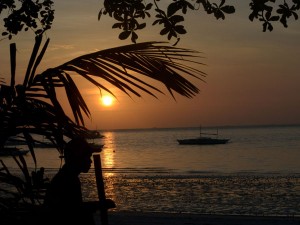Bohol rising from the rubble

The sun rises over boats on Panglao island in Bohol on October 18, three days after a 7.2 magnitude quake struck the island province. AFP
TAGBILARAN CITY, Philippines—”This way to the fault line.”
Wooden signs with this message have sprung up in the municipality of Inabanga to lead tourists to a fissure directly above the previously unknown fault whose movement caused the magnitude 7.2 earthquake that brought the province of Bohol to its knees.
Residents and local officials put up the signs after a number of tourists said they wanted to go to Barangay Anonang to see how the land cracked open there, with one side of the crevice rising like a wall several feet higher than the other side when the earth shook violently on the morning of October 15.
The earthquake caused many landslides, opened up fissures across numerous roads, caused bridges to collapse and reduced centuries-old stone churches to rubble across Bohol.
Since there was so much curiosity about the previously undiscovered fault line, provincial officials decided to turn the tragedy into a tourism opportunity by including it in tour packages.
Bohol Governor Edgar Chatto said he picked up the idea from geologist Dr. Jane Punongbayan of the Philippine Institute of Volcanology and Seismology, who told him that Japanese government used the same strategy after a strong earthquake a few years ago.
Besides, Chatto said several tourists were interested to see the ruins, judging from the number of inquiries they have received.
“Bohol still captures the tourists’ interests with so many other points,” he said. “People would like to see what happened to these churches after the earthquake.”
He pointed out that in some parts of Europe the ruins of old structures are tourist attractions.
Chatto said the ruins and the fault line in Bohol would be part of tourism packages because they are now part of the province’s history.
Six churches were reduced to rubble by the earthquake. These are the churches in the towns of Clarin, Inabanga, Loon, Maribojoc and Tubigon.
At least 17 other churches were heavily damaged. These are in Antequera, Baclayon, Bilar, Calape, Carmen, Corellas, Cortes, Danao, Dauis, Dimiao, Lila, Loay, Panglao, Sikatuna, Tagbilaran, Talibon and Trinidad.
Most of these churches were among the oldest in the country and many of them had been declared as heritage sites.
Plans to restore the churches were taken up during a meeting with Tourism Secretary Ramon Jimenez but the participants acknowledged this would require a lot of time and money.
Tour driver Thata Payot said business was slowly picking up since tourists had come to see the ruins of the old churches as well as the Chocolate Hills, especially after one of them split into two and others had chunks of earth crumbling down.
“Business is still a little slow but if there are requests to see the ruins, we take them there,” said Payot, who rents out vans to tourists for a living .
He said he used to have a minimum of five tours per week and earned P675 from each.
A week after the quake, he said, his tours were down to two a week, usually for tourists asking to be taken to specific points of interest.
The well-known Loboc River Cruise resumed operations on Thursday following repairs on its docking piers.
Tourists also continue to visit Panglao Island, which is known for its white-sand beaches and diving spots that were not very much affected by the quake.
Provincial Tourism Officer Josephine Cabarrus admitted that there were cancellations of bookings in Panglao but some of these were just moved to later dates.
Cabarrus said it was fortunate that the earthquake occurred in October, a lean month.
Data from the local tourism office show that foreign visitors are mostly Koreans and Japanese, who invariably go to the resorts on Panglao.
Nearly 2,770 Japanese tourists and 10,932 Koreans visited Bohol from January to June this year, 14 more than in the same period last year.
More than a week after the earthquake, the province continues to experience aftershocks, which Phivolcs said may continue for a week or two more.
But Boholanos have started to get back on their feet.
Even in Loon, one of the hardest-hit towns, some establishments have started to reopen.
A gas station of Petron opened on Tuesday. The First Consolidated Bank, M. Lhuillier Kuarta Padala and the LBC followed suit.
Maria Lesil Gallo, 36, of Barangay Cogon Norte in Loon was able to buy eggs, cooking oil, biscuits, and soap after she received money sent by relatives in Manila.
Still, she said, they needed relief goods from government and private organizations because she could not rely solely on her siblings who have families of their own.
Gallo lives with her parents Eufronia, 78, and Escolastico, 77.
Loon Mayor Lloyd Lopez said that the town is doing better than last week.
Water purifiers from the MMDA, Manila Water and the Armed Forces of the Philippines provide residents with potable water.














